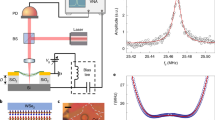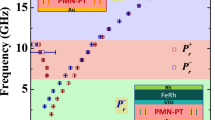Abstract
All magnets elongate and contract anisotropically when placed in a magnetic field, an effect referred to as Joule magnetostriction1. The hallmark of Joulian magnetostriction is volume conservation2, which is a broader definition applicable to self-accommodation of ferromagnetic, ferroelectric or ferroelastic domains in all functional materials3,4,5,6,7,8,9,10. Here we report the discovery of ‘giant’ non-volume-conserving or non-Joulian magnetostriction (NJM). Whereas Joulian strain is caused by magnetization rotation, NJM is caused by facile (low-field) reorientation of magnetoelastically and magnetostatically autarkic (self-sufficient) rigid micro-‘cells’, which define the adaptive structure, the origin of which is proposed to be elastic gradients ultimately caused by charge/spin density waves11,12,13. The equilibrium adaptive cellular structure is responsible for long-sought non-dissipative (hysteresis-free), linearly reversible and isotropic magnetization curves along all directions within a single crystal. Recently discovered Fe-based high magnetostriction alloys14,15 with special thermal history are identified as the first members of this newly discovered magnetic class. The NJM paradigm provides consistent interpretations of seemingly confounding properties of Fe-based alloys, offers recipes to develop new highly magnetostrictive materials, and permits simultaneously large actuation in longitudinal and transverse directions without the need for stacked composites.
This is a preview of subscription content, access via your institution
Access options
Subscribe to this journal
Receive 51 print issues and online access
$199.00 per year
only $3.90 per issue
Buy this article
- Purchase on Springer Link
- Instant access to full article PDF
Prices may be subject to local taxes which are calculated during checkout




Similar content being viewed by others
References
Joule, J. P. On the effects of magnetism upon the dimensions of iron and steel bars. Philos. Mag. 30, 76–87 (1847).
du Trémolet de Lacheisserie, É., Gignoux, D. & Schlenker, M. Magnetism: Fundamentals, Materials and Applications (Springer, 2002).
Khachaturyan, A. & Shatalov, G. Theory of macroscopic periodicity for a phase transition in the solid state. Sov. Phys. JETP 29, 557–561 (1969).
Clark, A. E. & Belson, H. S. Giant room-temperature magnetostrictions in TbFe2 and DyFe2 . Phys. Rev. B 5, 3642 (1972).
Chopra, H. D., Bailly, C. & Wuttig, M. Domain structures in bent In-22.5 at.%Tl polydomain crystals. Acta Mater. 44, 747–751 (1996).
Roytburd, A. L. Thermodynamics of polydomain heterostructures. I. Effect of macrostresses. J. Appl. Phys. 83, 228–238 (1998).
Chopra, H. D., Ji, C. H. & Kokorin, V. V. Magnetic-field-induced twin boundary motion in magnetic shape-memory alloys. Phys. Rev. B 61, R14913–R14915 (2000).
Sozinov, A., Likhachev, A. A., Lanska, N. & Ullakko, K. Giant magnetic-field-induced strain in NiMnGa seven-layered martensitic phase. Appl. Phys. Lett. 80, 1746–1748 (2002).
Jin, Y. M., Wang, Y. U., Khachaturyan, A. G., Li, J. F. & Viehland, D. Adaptive ferroelectric states in systems with low domain wall energy: Tetragonal microdomains. J. Appl. Phys. 94, 3629–3640 (2003).
Kaufmann, S. et al. Adaptive modulations of martensites. Phys. Rev. Lett. 104, 145702 (2010).
Grüner, G. Density Waves in Solids (Perseus, 2000).
Grüner, G. The dynamics of charge-density waves. Rev. Mod. Phys. 60, 1129–1181 (1988).
Chopra, H. D. & Wuttig, M. Non-Joulian magnetostriction (poster and abstract). Proc. MSE Conf. Symp. A03 (23–25 September, 2014).
Guruswamy, S., Srisukhumbowornchai, N., Clark, A. E., Restorff, J. B. & Wun-Fogle, M. Strong, ductile, and low-field-magnetostrictive alloys based on Fe-Ga. Scr. Mater. 43, 239–244 (2000).
Clark, A. E., Restorff, J. B., Wun-Fogle, M., Lograsso, T. A. & Schlagel, D. L. Magnetostrictive properties of body-centered cubic Fe-Ga and Fe-Ga-Al alloys. IEEE Trans. Magn. 36, 3238–3240 (2000).
Sullivan, M. R. & Chopra, H. D. Temperature- and field-dependent evolution of micromagnetic structure in ferromagnetic shape-memory alloys. Phys. Rev. B 70, 094427 (2004).
Rafique, S., Cullen, J. R., Wuttig, M. & Cui, J. Magnetic anisotropy of FeGa alloys. J. Appl. Phys. 95, 6939–6941 (2004).
Lisfi, A., Pokharel, S., Morgan, W., Warren, G. & Wuttig, M. The power of torque magnetometry: defect induced switching in hexaferrite nano-structures. Nanotechnology 25, 415702 (2014).
Xing, Q., Du, Y., McQueeney, R. J. & Lograsso, T. A. Structural investigations of Fe–Ga alloys: phase relations and magnetostrictive behavior. Acta Mater. 56, 4536–4546 (2008).
Clark, A. E. et al. Extraordinary magnetoelasticity and lattice softening in bcc Fe-Ga alloys. J. Appl. Phys. 93, 8621–8623 (2003).
Pirc, R., Blinc, R. & Scott, J. F. Mesoscopic model of a system possessing both relaxor ferroelectric and relaxor ferromagnetic properties. Phys. Rev. B 79, 214114 (2009).
Fu, J. Y. & Cross, L. E. On the flexoelectric effects in solid dielectrics: theories and applications. Ferroelectrics 354, 238–245 (2007).
Wuttig, M., Dai, L. & Cullen, J. Elasticity and magnetoelasticity of Fe–Ga solid solutions. Appl. Phys. Lett. 80, 1135–1137 (2002).
Sullivan, M. Wheatstone bridge technique for magnetostriction measurements. Rev. Sci. Instrum. 51, 382–383 (1980).
Lisfi, A., Ren, T., Khachaturyan, A. & Wuttig, M. Nano-magnetism of magnetostriction in Fe35Co65 . Appl. Phys. Lett. 104, 092401 (2014).
Acknowledgements
The authors appreciate the donation of single crystals by T. A. Lograsso. We thank S. Fähler for discussions. We thank S. Z. Hua for discussions, input on experimental design and help with magnetic and temperature dependent measurements. We thank J. Steiner, T. Ren, E. Gande and J. N. Armstrong for help with vibrating sample magnetometry and magnetostriction measurements, and assistance in collation of some images, experiments and sample preparation. M.W. acknowledges support from the National Science Foundation DMR-Metals grant 1206397 and H.D.C. acknowledges support from the National Science Foundation DMR-Condensed Matter Physics grants 1541236 (previously 1309712) and 0964830.
Author information
Authors and Affiliations
Contributions
Both authors jointly developed the concepts of NJM and reversibly linear non-dissipative magnets. Both authors jointly designed the experiments. Both authors contributed equally to writing this manuscript, analysing and interpreting the images and data. Micromagnetic studies were done by the first author (H.D.C.).
Corresponding authors
Ethics declarations
Competing interests
The authors declare no competing financial interests.
Extended data figures and tables
Extended Data Figure 1 Anisotropy of magnetostriction.
The data displays the angular dependence of magnetostriction along various directions in an as-quenched Fe73.9–Ga26.1 single crystal.
Extended Data Figure 2 Reproducibility of magnetostriction curves.
Reproducibility is shown for various traces in Fig. 1a and traces in Extended Data Fig. 1. Maximum field for each cycle is approximately ±3,150 Oe. Similarly reproducible traces were observed for the Fe82.9–Ga17.1 single crystal in Fig. 1b, not shown.
Extended Data Figure 3 Degradation of NJM characteristics in Fe73.9–Ga26.1 single crystal when cooled slowly from 1,033 K to room temperature (furnace cooled).
In comparison to volume expansion in all directions when an alloy of this composition was rapidly quenched (Fig. 1a), furnace (slow) cooling cause transverse magnetostriction to become slightly contractile. However, unlike conventional ferromagnets, the sample still exhibits a net volume increase, that is, NJM.
Extended Data Figure 4 Collage showing magnetic domains across the entire 5-mm-diameter circular single crystal sample of Fe73.9–Ga26.1, which was rapidly quenched from 1,033 K to room temperature.
The collage was prepared after polishing and etching the sample but before applying any magnetic field. Notice the existence of micromagnetic motifs along both [100] and [010] axes. Also notice the existence of APBs. The collage consists of high-resolution images and can thus be zoomed in for further analysis by the scientific community. Original magnification is ×5.
Extended Data Figure 5 Origin of magnetically and elastically compensated state.
a, Demagnetized state of a thin circular plate. b, Demagnetized state of a thin ferromagnetic film, λ100 = 0. c, Angular distortion of the diagonals for λ100 < 0 and λ100 > 0. d, Stress-free rectangular demagnetized state through twinning.
Extended Data Figure 6 Zero-field micromagnetic patterns of as-quenched Fe73.9–Ga26.1 crystal after cycling in saturation magnetic field.
A, a–c, Low-magnification images. Original magnification is ×10. B, a–c, High-magnification images. The pattern’s periodicity and scale equals that shown in Fig. 3. Original magnification is ×20.
Extended Data Figure 7 Polishing can cause deep buried subsurface deformation.
a, An apparently scratch-free Fe82.9–Ga17.1 single crystal after polishing but before etching. b, Subsequent etching in a 50:50 nitric acid and distilled water solution reveals numerous scratches.
Supplementary information
Supplementary Information
This file contains Supplementary Text. (PDF 173 kb)
Rights and permissions
About this article
Cite this article
Chopra, H., Wuttig, M. Non-Joulian magnetostriction. Nature 521, 340–343 (2015). https://doi.org/10.1038/nature14459
Received:
Accepted:
Published:
Issue Date:
DOI: https://doi.org/10.1038/nature14459
This article is cited by
-
Computer simulation of super-magnetoelastic behavior near critical region of magnetic materials based on phase-field method
Rare Metals (2023)
-
The critical role of spin rotation in the giant magnetostriction of La(Fe,Al)13
Science China Materials (2021)
-
Bounds on the Energy of a Soft Cubic Ferromagnet with Large Magnetostriction
Journal of Nonlinear Science (2020)
-
Micromagnetics of Galfenol
Journal of Nonlinear Science (2019)
-
Investigating non-Joulian magnetostriction
Nature (2018)
Comments
By submitting a comment you agree to abide by our Terms and Community Guidelines. If you find something abusive or that does not comply with our terms or guidelines please flag it as inappropriate.



